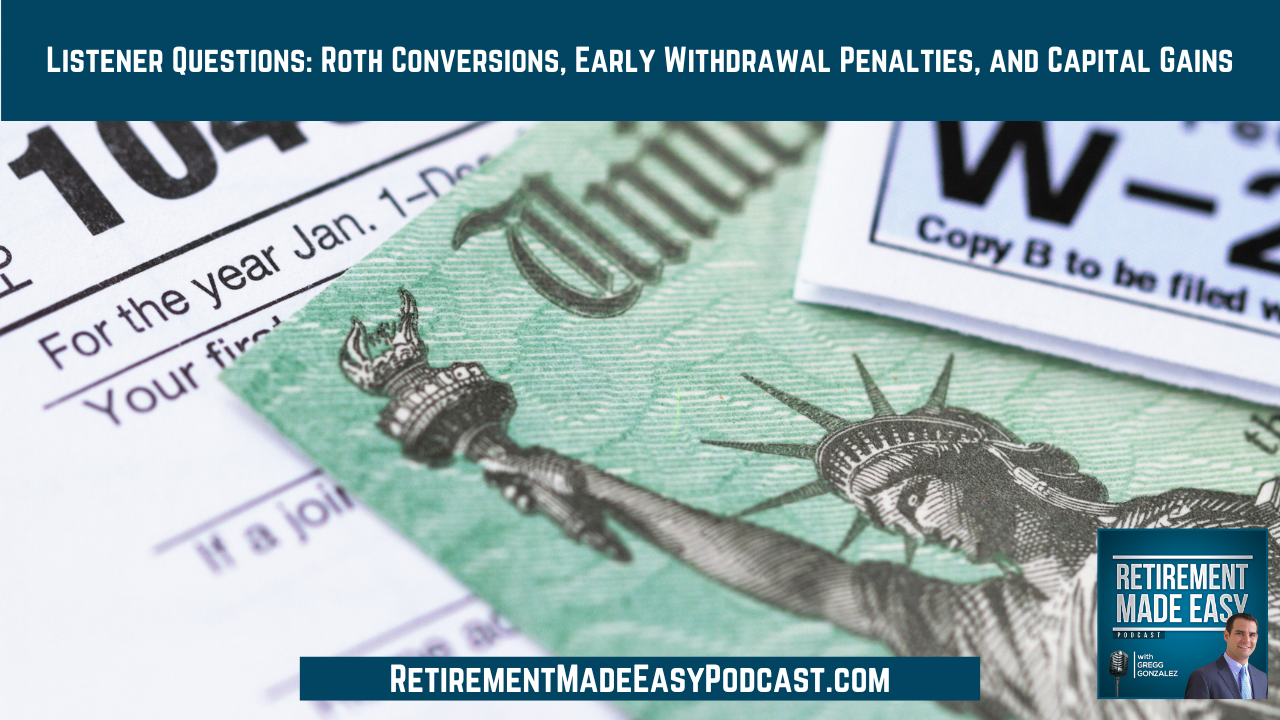
When are the best times for Roth conversions? Should you invest in a target-date fund? Can you avoid the 10% early withdrawal penalty? These are just a few of the questions I’ll tackle in this special Listener Questions edition of Retirement Made Easy!
Preparing for retirement is complicated at best. I want to make sure I’m consistently answering the questions that are top of mind for my listeners. So if you have a question, head on over to RetirementMadeEasyPodcast.com and submit one!
You will want to hear this episode if you are interested in…
- [0:28] Submit questions are RetirementMadeEasyPodacst.com
- [2:57] Question #1: When are the best times for Roth conversions?
- [8:23] Question #2: Should you invest in a target-date fund?
- [13:59] Question #3: How do I request a lump sum pension?
- [16:57] Question #4: Can you avoid the 10% early withdrawal penalty?
- [19:55] Question #5: How does 401K matching work?
- [22:28] Question #6: How does the survivor benefit work when divorced?
- [25:07] Question #7: How do long-term capital gains taxes work?
When are the best times for Roth conversions?
A Roth conversion is taking money out of an IRA, paying the taxes on it, and moving it to a Roth IRA where it can grow tax-free. The conversion is taxed as ordinary income. When should you do it? When you find yourself in a lower-income year.
Maybe you’ve been laid off and are unemployed for a season. You could also do a conversion when the market is down. Let’s say your portfolio plummeted. You could pay taxes on the lower amount and move it to a Roth IRA until the market rebounds. Then the growth will be tax-free.
If you foresee that you’ll be in a higher tax bracket in the future—or that the tax situation will worsen—it can make sense to do a Roth conversion.
Should you invest in a target-date fund?
A retirement or target-date fund hinges on the premise that your projected retirement age determines how you’ll invest. If you’re younger, you’ll be invested more aggressively. If you’re older, it will be more conservative. But it’s basically saying that every person has the same risk tolerance, the same amounts saved, the same goals, etc. No one should invest their money the same way. It needs to be individualized. What’s more important? The returns you’re getting—i.e. the value you get for the fees that you pay.
Can you avoid the 10% early withdrawal penalty?
A 57-year-old woman recently lost her husband. She has to start taking distributions from her deceased husband’s IRA to fund her lifestyle. Can she avoid the 10% early withdrawal penalty? Yes—but the money needs to be moved into a beneficiary IRA. Why?
Because there is never a 10% withdrawal penalty from beneficiary IRAs. You can make monthly withdrawals without being hit by the penalty. What can you do if it’s too late and you’ve already moved the money to your account? Listen to find out!
How do long-term capital gains taxes work?
If you buy a stock for $10 and it’s now worth $110, you have $100 per share of profit. That’s an unrealized capital gain (because you haven’t sold it and realized the profit). When you do sell it, you’ll be hit with long-term capital gains tax.
This listener was told they’d have no “income” in their first year of retirement so they could sell the stock without paying long-term capital gains. Thankfully, they did not do this, because that’s not true.
You can’t just sell millions of dollars of securities and not expect to pay taxes. If you hit a certain threshold you will have to pay taxes. You may pay zero on a certain dollar amount. But once you hit that threshold, you’ll have to pay 15–20%.
Resources & People Mentioned
Connect With Gregg Gonzalez
- Email at: Gregg@RetireSTL.com
- Podcast: https://RetirementMadeEasyPodcast.com
- Website: https://StLouisFinancialAdvisor.com
- Follow Gregg on LinkedIn
- Follow Gregg on Facebook
- Follow Gregg on YouTube



